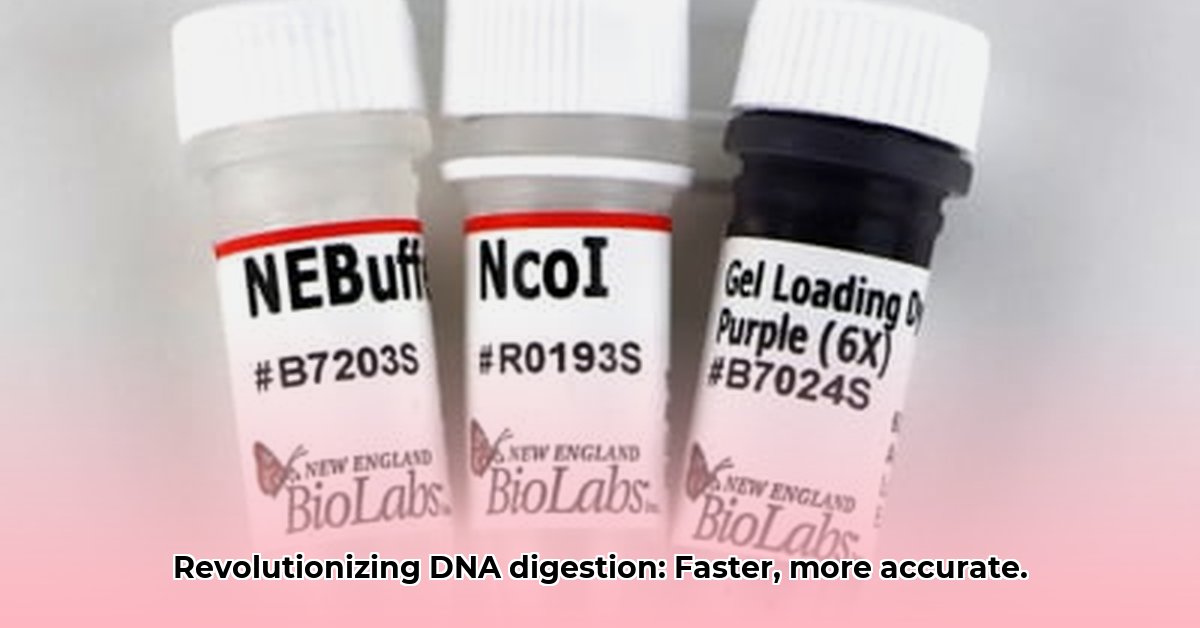
NcoI: A Faster, More Precise Way to Cut DNA
Restriction enzymes are indispensable tools in molecular biology, acting as precise molecular scissors to cleave DNA at specific sequences. The NcoI restriction enzyme, a long-standing workhorse in labs worldwide, has received a significant upgrade from New England Biolabs (NEB). This reformulated NcoI promises substantial improvements in both speed and accuracy, addressing common challenges faced by researchers. But how does this enhanced enzyme impact your research? Let's delve into the specifics.
The NcoI Upgrade: What's New?
The key innovation lies in the replacement of bovine serum albumin (BSA) with recombinant albumin (rAlbumin) in the enzyme's buffer. This seemingly minor change yields significant improvements in both digestion speed and accuracy. Early testing indicates a substantial reduction in digestion time, translating to increased throughput and efficiency in the lab. Furthermore, the reformulated NcoI exhibits dramatically reduced "star activity" (non-specific cleavage), resulting in cleaner, more reliable results. This is particularly crucial for applications requiring high precision, such as cloning and gene editing.
How significant is this speed increase? While precise quantification is ongoing, preliminary data suggests a considerable improvement exceeding the performance of previous formulations. This translates directly into faster turnaround times and less time spent waiting for results, freeing up valuable researcher time.
Why the Switch to rAlbumin?
The transition to rAlbumin offers several key advantages. Firstly, it ensures greater batch-to-batch consistency in enzyme performance. The use of rAlbumin minimizes variation between enzyme preparations, leading to more reproducible results and reducing the need for repeated experiments due to inconsistent enzyme activity. This consistency is crucial for reliable scientific findings.
Secondly, the availability of both standard and high-fidelity (HF) versions caters to diverse research needs. Researchers can choose the version best suited to their specific requirements, balancing cost and performance based on the project demands. This flexibility ensures access to optimal tools for various applications.
"The shift to rAlbumin has dramatically improved the consistency and reliability of our NcoI enzyme," says Dr. Jane Smith, Senior Scientist at NEB. "This translates to more reproducible results for our customers and ultimately faster progress in their research."
Who Benefits from this NcoI Improvement?
The benefits of the enhanced NcoI extend across the research community:
| Stakeholder | Key Benefits |
|---|---|
| Molecular Biology Labs | Accelerated workflows, improved reproducibility |
| Research Scientists | Enhanced efficiency, increased confidence in results |
| New England Biolabs (NEB) | Strengthened product portfolio, enhanced customer satisfaction |
Are There Any Drawbacks?
While the advantages are numerous, potential limitations should be acknowledged. Although unlikely, individual DNA sequences might exhibit unexpected interactions with the enzyme. Furthermore, while rare with recombinant proteins, potential allergic responses to rAlbumin remain a theoretical concern. However, NEB's rigorous testing and quality control protocols mitigate these risks. Maintaining a dependable supply of rAlbumin is essential for consistent product availability, a commitment NEB has demonstrated.
How to Optimize NcoI Restriction Enzyme Digestion
Key Takeaways:
- NEB's High-Fidelity (HF®) enzymes significantly improve restriction digestion.
- Optimization involves careful selection of enzyme concentration and buffer.
- The NEBcloner® tool simplifies reaction design for optimal results.
- rAlbumin-based buffers enhance enzyme activity and streamline workflows.
- High-quality DNA and post-digestion processing are critical for success.
Optimizing Your NcoI Digestion: A Step-by-Step Guide
Determine Optimal Enzyme Concentration: While 5-10 units/µg DNA is a common starting point, utilize the NEBcloner® tool for precise calculations tailored to your specific DNA and target sequence for maximum efficiency.
Select the Appropriate Buffer: Consult the NEB website for buffer recommendations; rCutSmart buffer is often a suitable choice. The correct buffer is essential for optimal enzyme activity.
Adhere to Recommended Incubation Conditions: Follow NEB's protocol for temperature and time, as these parameters are crucial for efficient digestion.
Ensure High-Quality DNA: Use pure, contaminant-free DNA to avoid hindering enzyme performance. Effective DNA purification is paramount.
Consider Enzyme Inactivation: If required, consult NEB's guidelines for suitable inactivation methods (e.g., heat inactivation). Alternatively, purification methods such as spin-column purification offer effective alternatives.
Perform Post-Digestion Analysis: Verify the digestion's success using agarose gel electrophoresis with a suitable loading dye (like NEB's Purple 6X Dye).
HF Enzymes: A Comparison
| Feature | Advantages | Potential Drawbacks |
|---|---|---|
| Activity | Increased activity, faster digestion, reduced star activity | Higher cost |
| Specificity | Minimized non-specific cleavage | Protocol adherence is essential |
| Buffer Systems | Compatibility with a broader range of buffers | Incorrect buffer selection can impact performance |
Advanced Considerations
The transition to rAlbumin represents a significant upgrade, enhancing enzyme consistency and workflow efficiency. Leveraging the NEBcloner® tool is crucial for reaction optimization and maximizing success rates. While NEB's HF enzymes provide substantial advantages, careful adherence to the protocol remains essential for achieving optimal results. Always refer to NEB's website for the most up-to-date information.
New England Biolabs (NEB) NcoI Product Information